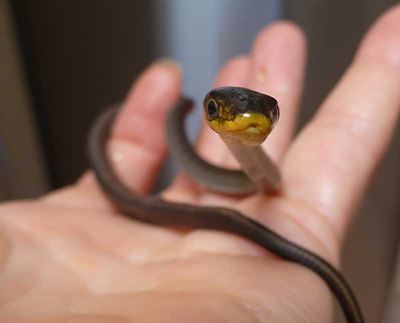Hatching a Green Tree Snake
Thursday, February 18, 2016
WIRES is often called, especially about reptiles as people are nervous about seeing them in close proximity to their house or yard. In many cases our volunteers are able to explain and reassure people that reptiles really just want to be left alone and will do everything they can to avoid human contact.
Sometimes reptiles do need to be relocated, either because the environment is unsuitable or they are in danger of harm. Recently WIRES was called to relocate a Green Tree Snake in Northern Sydney.
As usual the snake was contained in a reptile bag for transportation to an appropriate release site and subsequently released. Later that day when the reptile bag was being packed away Sara realised it was not entirely empty.
She was very surprised to find inside a single Green tree snake egg! Usually these snakes will lay a clutch of many eggs and Sara assumes she had laid most of the eggs prior to rescue and then released a final one under the stress of the rescue.

Sara carefully placed the egg in her incubator. She tended it carefully for 3 months, controlling the humidity and temperature between 28- 30 degrees, and a few days ago it hatched! The tiny young snake was about 24 cm long.
Young reptiles are immediately self-sufficient and in the wild will disperse rapidly once hatched. Sara was able to quickly get this tiny young Green tree snake back to the wild without delay.
Green tree snakes are very common and generally inconspicuous. They are slender, non-venomous, diurnal reptiles with a bright yellow underside. They feed mainly on frogs, small fish, and small reptiles.
Their preferred habitat is quite varied and includes bushlands, well-vegetated banks of rivers and creeks, places with lush vegetation and long grass, as well as rainforest edges and eucalypt forests.
Recent Posts
WIRES launches its first wildlife rehabilitation centre - Mullyang
WIRES Emergency Response in the wake of ex-tropical cyclone Alfred
International Women’s Day Volunteer Spotlight: Shelley
Tropical Cyclone Alfred – Emergency Wildlife Advice
Interview with WIRES Training and Development
Celebrating Women in Science: The Journey of Holly, Wildlife Conservationist and WIRES Team Member
